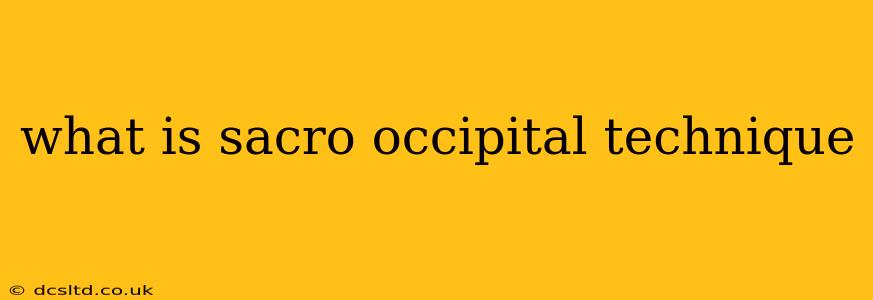Sacro-Occipital Technique (SOT) is a gentle, whole-body chiropractic approach that focuses on the relationship between the sacrum (the triangular bone at the base of the spine) and the occiput (the base of the skull). This technique views the body as an integrated unit, believing that misalignments in the spine, particularly in these key areas, can affect the entire nervous system and overall health. Unlike some other chiropractic adjustments which involve high-velocity, short-amplitude thrusts, SOT utilizes a more subtle and specific approach.
SOT practitioners assess the patient's posture, range of motion, and neurological function to identify areas of dysfunction. They then use a variety of techniques, including gentle adjustments, specific stretches, and postural exercises, to restore proper alignment and function. A key aspect of SOT is its emphasis on addressing the underlying causes of spinal misalignment, rather than just treating the symptoms.
How Does SOT Work?
SOT's core principle revolves around the idea that spinal misalignments can interfere with the body's natural healing processes. These misalignments can impinge on nerves, restricting the flow of nerve impulses and affecting various organ systems. By restoring proper alignment between the sacrum and occiput, SOT aims to improve nerve communication and enhance the body's ability to heal itself.
The technique involves a detailed examination to pinpoint the specific areas of subluxation (misalignment). This assessment often involves:
- Postural analysis: Observing the patient's posture to identify imbalances.
- Palpation: Feeling the spine to detect areas of tenderness, muscle tension, and joint restriction.
- Range of motion testing: Assessing the flexibility and movement of the spine.
- Neurological testing: Evaluating reflexes and other neurological functions.
Based on this assessment, the chiropractor will develop a personalized treatment plan. This plan typically involves:
- Gentle adjustments: Precise adjustments are made to the spine, particularly focusing on the sacrum and occiput. These adjustments are often much gentler than those used in other chiropractic techniques.
- Specific stretches and exercises: Patients are often given exercises to improve flexibility, strengthen muscles, and improve posture.
- Lifestyle modifications: Advice on posture, ergonomics, and nutrition may be given to support the healing process.
What Conditions Might SOT Treat?
While SOT is not a cure-all, practitioners believe it can be beneficial for a variety of conditions, including:
- Back pain: Addressing sacroiliac joint dysfunction.
- Neck pain: Improving cervical spine alignment.
- Headaches: Reducing tension and improving blood flow.
- Sciatica: Relieving nerve compression.
- Postural problems: Improving overall body alignment.
- Digestive issues: Improving nerve function related to digestion.
It's important to note that the effectiveness of SOT, like any chiropractic treatment, varies from person to person.
Is SOT Safe?
SOT is generally considered safe when performed by a qualified and experienced chiropractor. However, as with any manual therapy, there is a small risk of side effects such as temporary soreness or discomfort. It is crucial to choose a licensed and experienced SOT practitioner.
What are the Differences Between SOT and Other Chiropractic Techniques?
Unlike some high-velocity, low-amplitude thrust techniques, SOT employs a gentler, more specific approach. Other chiropractic techniques might focus on a wider range of spinal adjustments, whereas SOT places particular emphasis on the sacrum-occiput relationship and its impact on the whole body.
What are the Benefits of SOT?
The potential benefits of SOT include improved posture, reduced pain, increased range of motion, and improved overall well-being. It aims to address the root cause of problems rather than just treating symptoms.
Does SOT use any special equipment?
While not strictly requiring special equipment, SOT practitioners may utilize various tools to assist in the assessment and treatment process. These might include wedges, blocks, or other devices designed to support specific spinal positions during adjustments. However, the core of SOT remains the practitioner's skill in palpating and manipulating the spine.
This information is for general knowledge and does not constitute medical advice. Always consult with a qualified healthcare professional before starting any new treatment.
